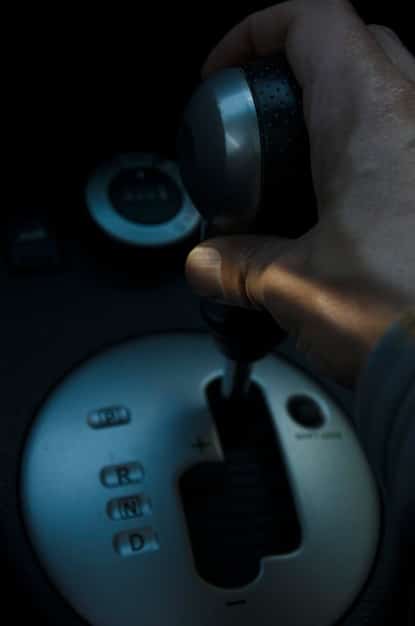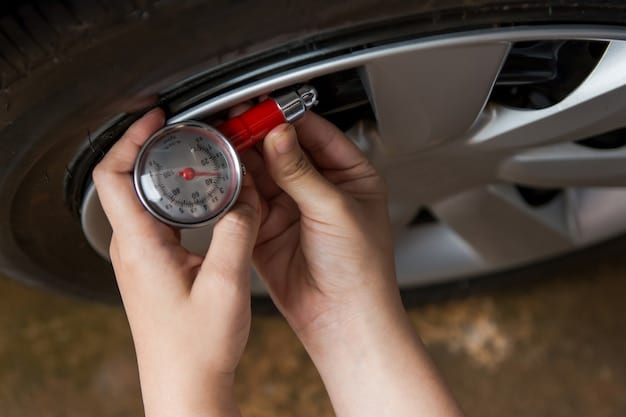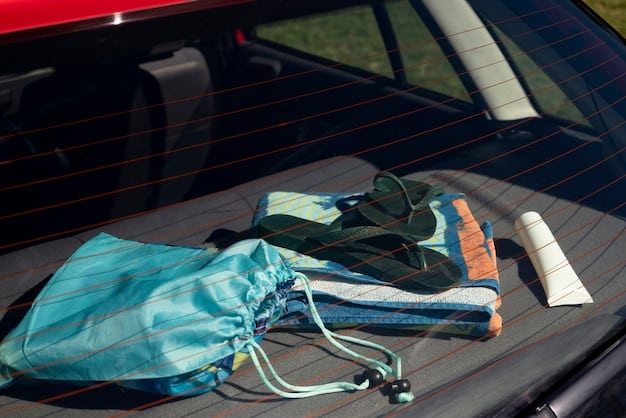Learn Basic Car Maintenance: Road Trip Essentials for Drivers

Learning basic car maintenance is crucial for modern drivers, as it ensures vehicle reliability, enhances safety during road trips, and empowers individuals to prevent and address unexpected breakdowns, fostering a more confident and independent travel experience.
Embarking on a road trip offers unparalleled freedom and adventure, but unpreparedness can quickly turn excitement into frustration. To truly enjoy the open road and ensure peace of mind, it’s essential for every driver to learn basic car maintenance: essential skills for road trips and unexpected breakdowns. This foundational knowledge isn’t just for mechanics; it empowers you to handle minor issues, prolong your vehicle’s life, and navigate journeys with confidence, transforming potential mishaps into mere stops along the way.
understanding your vehicle: the foundation of reliability
Understanding your vehicle goes beyond knowing how to drive it. It’s about recognizing its basic needs and the signals it sends. Every car is a complex machine, but many of its fundamental components and their functions are surprisingly straightforward to learn. This basic understanding forms the bedrock of preventive maintenance, crucial for any long journey.
Before you even think about hitting the road, familiarize yourself with your car’s owner’s manual. It’s a goldmine of information, detailing everything from recommended tire pressures to fluid types and maintenance schedules. Many drivers overlook this resource, yet it contains the most accurate and specific guidelines for their particular vehicle.
deciphering dashboard warning lights
Modern vehicles are equipped with sophisticated diagnostic systems that communicate through dashboard warning lights. Ignoring these can lead to significant problems. Understanding what each symbol indicates is the first step in addressing potential issues before they escalate.
- Check Engine Light: This universal symbol can mean anything from a loose gas cap to a serious engine malfunction. While often not an immediate emergency, it warrants attention.
- Oil Pressure Warning: Indicates low oil pressure, which can cause severe engine damage if not addressed promptly. Pull over safely and check your oil.
- Battery Warning: Points to an issue with the charging system, possibly a failing alternator or battery. This could leave you stranded.
- Tire Pressure Monitoring System (TPMS) Light: Alerts you to low tire pressure, which affects safety, fuel efficiency, and tire longevity.
Each light has a specific context, and knowing its meaning allows for a proactive response. This knowledge is not just about fixing things; it’s about prevention and ensuring your vehicle operates within its optimal parameters, reducing the likelihood of a roadside emergency.
Beyond dashboard lights, paying attention to how your car feels and sounds is equally important. Unusual noises, vibrations, or changes in handling can signify an emerging problem. A keen awareness of your vehicle’s normal operation enables you to spot deviations early, often saving you from more costly repairs down the line. This keen observation is a key skill for any vigilant driver.
essential fluid checks: the lifeblood of your car
Just as humans need water to survive, your car relies on various fluids to operate smoothly and efficiently. Regularly checking these fluid levels is one of the simplest yet most effective forms of preventive maintenance. Ensuring they are at the correct levels and in good condition can prevent overheating, engine damage, and brake failure, among other issues.
These checks should ideally be performed monthly, and definitely before any extended road trip. It’s a quick process that requires minimal tools and can save you from inconvenient and expensive breakdowns. The owner’s manual will guide you on where to locate the dipsticks and reservoirs for each fluid.
oil, coolant, and brake fluid: your top priorities
Three fluids are particularly critical for your car’s health and safety:
- Engine Oil: The lifeblood of your engine, lubricating moving parts and preventing friction. Check it when the engine is cold and on a level surface. Low or dirty oil can lead to engine overheating and catastrophic failure.
- Coolant (Antifreeze): Keeps your engine from overheating in warm weather and freezing in cold. Check the reservoir level and ensure it’s between the “min” and “max” lines.
- Brake Fluid: Essential for your braking system. A low level can indicate worn brake pads or a leak, compromising your ability to stop safely.
Beyond these, also consider power steering fluid and transmission fluid, though they typically require less frequent checking unless you notice specific issues. Power steering fluid ensures smooth steering, while transmission fluid is vital for gear shifting and transmission longevity.
Regular maintenance of these fluids not only extends the life of your vehicle but also significantly contributes to your safety on the road. Neglecting fluid checks can lead to serious mechanical failures, which are particularly undesirable when you’re miles away from home on a road trip. A small investment of time now can prevent significant headaches later.
tire care fundamentals: grip, safety, and efficiency
Tires are your car’s only point of contact with the road, making their condition paramount for safety, handling, and fuel efficiency. Neglecting tire maintenance can lead to blowouts, reduced traction, and uneven wear, all of which compromise your road trip experience and safety. Understanding basic tire care is a fundamental skill for any driver.
Proper tire inflation is often overlooked. Underinflated tires can lead to increased rolling resistance, reducing fuel economy and generating excessive heat, which heightens the risk of a blowout. Overinflated tires, on the other hand, reduce the contact patch with the road, diminishing traction and causing premature wear in the center of the tread.
checking tire pressure and tread depth
Consistently checking your tire pressure is one of the easiest and most impactful maintenance tasks. The recommended pressure is usually found on a sticker inside the driver’s side door jamb or in your owner’s manual, not on the tire’s sidewall.
- Pressure Check: Use a reliable tire gauge. Check tires when cold for the most accurate reading. Don’t forget the spare tire, as it could be your lifesaver in an emergency.
- Tread Depth: This indicates how much grip your tires have. The “penny test” is a simple method: insert a penny into a tread groove with Lincoln’s head upside down. If you can see the top of Lincoln’s head, your tread is too shallow, and the tires need replacement.
Rotation and alignment also play a crucial role in tire longevity and vehicle performance. Regular tire rotations ensure even wear across all four tires, extending their lifespan. Wheel alignment, meanwhile, ensures that your wheels are properly angled and parallel to each other, preventing uneven tire wear and improving handling. Vibrations in the steering wheel or a car pulling to one side are often indicators of alignment issues.
Investing a few minutes regularly in tire care not only enhances your driving experience but significantly improves safety on the road. Properly maintained tires provide better braking, handling, and stability, which are critical when navigating diverse road conditions during a lengthy road trip. This simple routine can prevent a major roadside headache.

battery basics: powering your journey
Your car’s battery is the silent workhorse that powers everything from starting the engine to running the lights and infotainment system. A dead battery is a common and frustrating reason for roadside assistance calls, especially during road trips where you might be far from help. Understanding basic battery maintenance can save you from being stranded.
Car batteries typically last between three to five years, but this can vary based on climate and driving habits. Extreme temperatures, whether hot or cold, can significantly affect battery life. Regular short trips that don’t allow the battery to fully recharge can also shorten its lifespan.
signs of a weak battery and jump-starting safety
Recognizing the symptoms of a dying battery is crucial. Slow cranking when starting the car, dim headlights when the engine is off, or the “check battery” light illuminating on your dashboard are all red flags. Addressing these signs early can prevent a complete failure.
- Corrosion: Check battery terminals for white or greenish powdery buildup. This corrosion can impede electrical flow and should be cleaned with a wire brush and a battery terminal cleaner.
- Secure Connections: Ensure the battery terminals are tightly connected. Loose connections can lead to intermittent power issues.
Knowing how to jump-start a car is an essential skill. Always use jumper cables correctly, connecting positive to positive and negative to negative, ensuring the donor car is off before connecting and starting. Incorrect connections can damage your vehicle’s electrical system or cause serious injury. Always consult your owner’s manual for specific instructions for your vehicle.
Consider carrying a portable jump starter, especially for road trips. These compact devices eliminate the need for another car, offering a self-sufficient solution for a dead battery. It’s a worthwhile investment for peace of mind, ensuring you can quickly get back on the road without relying on external assistance. Proactive battery care ensures your car starts reliably, no matter where your adventure takes you.
lighting and wiper blades: visibility and safety tools
Visibility is paramount for safe driving, especially during long road trips that can span various weather conditions and times of day. Your car’s lighting system and wiper blades are critical components in ensuring you can see and be seen. Regularly inspecting and maintaining these elements is a simple yet vital aspect of car care.
Headlights, taillights, turn signals, and brake lights all play specific roles in informing other drivers of your presence and intentions. Dim or non-functional lights can lead to dangerous situations and even traffic citations.
checking all lights and replacing wiper blades
A quick walk-around of your vehicle at least once a month, or before any major trip, should include checking all exterior lights. Turn on your headlights, taillights, and hazards, then press the brake pedal to ensure your brake lights illuminate. If a bulb is out, replace it promptly. This is a simple fix that significantly impacts safety.
- Headlight Clarity: Over time, headlight lenses can become cloudy, reducing light output. Headlight restoration kits are available to clear them, improving visibility.
- Wiper Blade Wear: Wiper blades degrade due to exposure to sun and harsh weather. Signs of wear include streaking, skipping, or audible chattering. Replace them every six to twelve months, or as soon as you notice these signs.
Effective wiper blades are crucial for clear visibility during rain, snow, or even light mist. Don’t wait until a severe storm to realize your blades are ineffective. Visibility can often mean the difference between a safe journey and an accident, emphasizing the importance of these often-overlooked components.
Ensuring your lights and wiper blades are in top condition is a small effort with a huge impact on your driving safety. It contributes not only to your ability to see the road ahead but also to other drivers’ ability to anticipate your movements, fostering a safer environment for everyone sharing the road. This small act of maintenance is a pillar of responsible driving.
emergency kit essentials: prepared for the unexpected
Even with meticulous maintenance, unexpected breakdowns can occur. A well-stocked emergency kit is your best friend when faced with minor roadside issues or more significant unplanned stops. While comprehensive car maintenance minimizes risks, being prepared for the unforeseen is a mark of a truly ready traveler. An emergency kit acts as your personal roadside assistance, offering immediate solutions.
The contents of your kit should be tailored to the length of your trip, the climate you’ll be traveling through, and the number of passengers. However, some core items are universally beneficial and should be in every vehicle, offering basic relief and communication capabilities.
must-have items for roadside emergencies
Consider these items as your fundamental toolkit for handling common issues and ensuring safety:
- Jumper Cables: As discussed, essential for a dead battery.
- First-Aid Kit: For minor injuries. Include bandages, antiseptic wipes, pain relievers, and any personal medications.
- Flashlight with Extra Batteries: For nighttime inspections or repairs.
- Basic Tool Kit: Pliers, screwdrivers, adjustable wrench, and tire pressure gauge.
- Duct Tape and Zip Ties: Simple fixes for many temporary repairs.
- Reflective Triangles or Flares: To warn other drivers of your stopped vehicle, especially at night.
- Phone Charger and Portable Power Bank: Critical for communication, especially if stranded.
- Water and Non-Perishable Snacks: Especially important in remote areas or hot climates.
- Warm Blanket and Rain Poncho: For personal comfort in unexpected weather changes.
Beyond these practical tools, having an updated map (physical or downloaded offline) and knowing your vehicle’s roadside assistance contact information are also invaluable. While smartphones are ubiquitous, signal dead zones can still leave you without navigation or communication. Preparing for these scenarios means less stress and a quicker resolution to unexpected challenges.
The peace of mind that comes from knowing you’re prepared for most roadside eventualities is invaluable. An emergency kit is not just for breakdowns; it’s also for comfort and safety in less-than-ideal situations. It’s an essential investment for any road trip enthusiast, transforming potential crises into manageable inconveniences, allowing you to quickly resume your journey with minimal fuss.

pre-trip checklist: final preparations for a smooth ride
Before any significant road trip, a comprehensive pre-trip checklist is your last line of defense against unforeseen issues. This final review ensures that all previous maintenance steps have been covered and that your vehicle is truly ready for the demands of extended travel. It’s about systematically verifying everything, leaving no stone unturned.
Even if you’ve been diligent with regular maintenance, a dedicated pre-trip inspection catches anything that might have been missed or any new issues that have emerged. This proactive approach significantly reduces the likelihood of encountering problems miles away from home.
a comprehensive review before departure
Go through each item meticulously. This checklist blends the routine with the specific needs of a longer journey:
- Check All Fluids Again: Engine oil, coolant, brake fluid, power steering fluid, and windshield washer fluid. Top up as needed.
- Inspect Tires (including Spare): Pressure, tread depth, and overall condition. Verify the jack and lug wrench are present and functional.
- Test All Lights: Headlights (high and low beam), taillights, brake lights, turn signals, and hazard lights.
- Check Wipers and Washer Fluid: Ensure blades are clean and effective, and the reservoir is full.
- Brake Performance: Listen for unusual noises and feel for any spongy pedal feel. If in doubt, have them inspected.
- Belts and Hoses: Look for cracks, frays, or stiffness. Ensure they are correctly tensioned.
- Documentation: Ensure your driver’s license, registration, and insurance are current and easily accessible.
- Route Planning: Have a primary and alternative route planned, consider fuel stops, and potential rest areas.
Beyond the car itself, remember personal preparations like packing essentials, having charging cables for devices, and ensuring you have enough rest before beginning your journey. Driving while fatigued is as dangerous as driving under the influence.
By diligently adhering to this pre-trip checklist, you’re not just preparing your car; you’re preparing yourself for a stress-free and enjoyable adventure. It transforms potential anxieties into confident anticipation, allowing you to focus on the joy of discovery and the beauty of the journey, rather than worrying about what might go wrong. This thorough preparation is the hallmark of a wise traveler.
| Key Point | Brief Description |
|---|---|
| 🚗 Vehicle Understanding | Familiarize yourself with your car’s owner’s manual and dashboard warning lights for proactive maintenance. |
| 💧 Fluid Checks | Regularly check engine oil, coolant, and brake fluid to prevent mechanical failures and ensure safety. |
| टायर Tire Care | Maintain proper tire pressure, check tread depth, and ensure rotations for safety and fuel efficiency. |
| 🛠️ Emergency Preparedness | Assemble a comprehensive emergency kit, including jumper cables, first-aid, and reflective warnings. |
frequently asked questions
It’s generally recommended to check your car’s essential fluid levels, such as engine oil, coolant, and brake fluid, at least once a month. This frequency allows you to catch any potential issues early and top up fluids as needed, especially before embarking on a long road trip or significant travel, ensuring your vehicle remains in optimal operating condition and preventing unexpected breakdowns.
The “penny test” is a simple method to check your tire’s tread depth. Insert a penny into the tire tread groove with Abraham Lincoln’s head upside down and facing you. If you can see the very top of Lincoln’s head, your tread is likely too shallow (less than 2/32 of an inch), indicating that your tires need to be replaced for optimal safety and performance on the road.
A well-stocked car emergency kit should include jumper cables, a first-aid kit, a flashlight with extra batteries, reflective triangles or flares, basic tools (like a screwdriver set and adjustable wrench), duct tape, zip ties, and a portable phone charger. These items can help you manage minor issues and stay safe while waiting for assistance during a roadside emergency.
It’s advisable to have your car’s battery checked annually, especially if it’s nearing three years old, or before cold weather sets in. Most auto parts stores offer free battery testing. Regular checks can help identify a weakening battery before it leaves you stranded, ensuring reliable starts and power for your vehicle’s electrical systems during daily use and extended trips.
Understanding dashboard warning lights is crucial because they are your car’s way of communicating potential problems. Ignoring these lights, such as the “Check Engine” or “Oil Pressure” warning, can lead to serious mechanical issues, costly repairs, or even dangerous breakdowns. Early recognition allows for timely intervention, often preventing minor issues from escalating into major safety hazards or expensive repairs.
conclusion
Mastering basic car maintenance is more than just a chore; it’s an investment in your safety, peace of mind, and the longevity of your vehicle. By understanding fundamental checks like fluid levels, tire pressure, and battery health, you empower yourself to prevent common issues and react confidently to unexpected situations. These essential skills not only make your road trips smoother and more enjoyable but also foster a deeper connection with your vehicle, transforming you from a passive driver into a prepared and proactive journey-maker.





